من الضروري ضمان سهولة اكتشاف جميع صفحات موقعك الإلكتروني بواسطة محركات البحث. تساعد خريطة الموقع XML المُحسّنة لمحركات البحث برامج الزحف والبوتات على التنقل في كل صفحة من موقعك، مما يزيد من فرص الحصول على تصنيفات أعلى وظهور أكبر.
ترجمة خريطة موقعك مهمة بنفس القدر، إذ تزيد من عدد الصفحات المفهرسة بلغات متعددة. لذلك، فإن فهم كيفية ترجمة خريطة موقع Yoast SEO XML يمكن أن يوفر فوائد كبيرة للوصول إلى جمهور عالمي.
ما هي خريطة موقع XML؟

لتبسيط الأمر ، فإن خريطة موقع XML هي في الأساس ملف يسرد جميع الصفحات المهمة لموقع الويب. يضمن استخدام خريطة موقع XML أن محركات البحث مثل Google يمكنها العثور على هذه الصفحات والزحف إليها وفهم بنية موقع الويب الخاص بك. لذلك فهي في الأساس طريقة موحدة لإدراج صفحات موقع الويب والتأكد من إمكانية اكتشافها بواسطة محركات البحث. يتكون خريطة موقع XML من أجزاء متعددة تشمل:
- إعلان إصدار XML - تستخدمه برامج زحف محركات البحث لتحديد نوع الملف الذي تقرأه.
- مجموعة عناوين URL - توفر تفاصيل البروتوكول لمحرك البحث.
- عنوان URL - يوفر قائمة بعناوين URL لصفحات الويب على موقع الويب.
- Lastmod - توفر أحدث تاريخ تم فيه تعديل صفحة الويب.
عند استخدام خرائط مواقع XML ، من المهم أن تفهم أنه يجب أن تتبع هذه البنية حتى تكون صالحة. يمكن أن تحتوي خريطة موقع XML واحدة على ما يصل إلى 50000 عنوان URL ويمكن أن يصل حجمها إلى 50 ميغابايت. ومع ذلك ، من المهم الإشارة إلى أن عدد عناوين URL في ملف Sitemap يؤثر على سرعة الزحف.
يتم تحديد سرعة الزحف بشكل أساسي من خلال نسبة:
حركة المرور على موقع الويب الخاص بك / عدد الصفحات التي لديك. هذا يعني أنه إذا كان لديك موقع ويب به حركة مرور قليلة ، فلن تحتاج إلى إرسال 50 ألف عنوان URL في خريطة موقعك. خلاف ذلك ، ربما تتم فهرسة موقع الويب الخاص بك ببطء.
الفرق بين خرائط مواقع XML و HTML
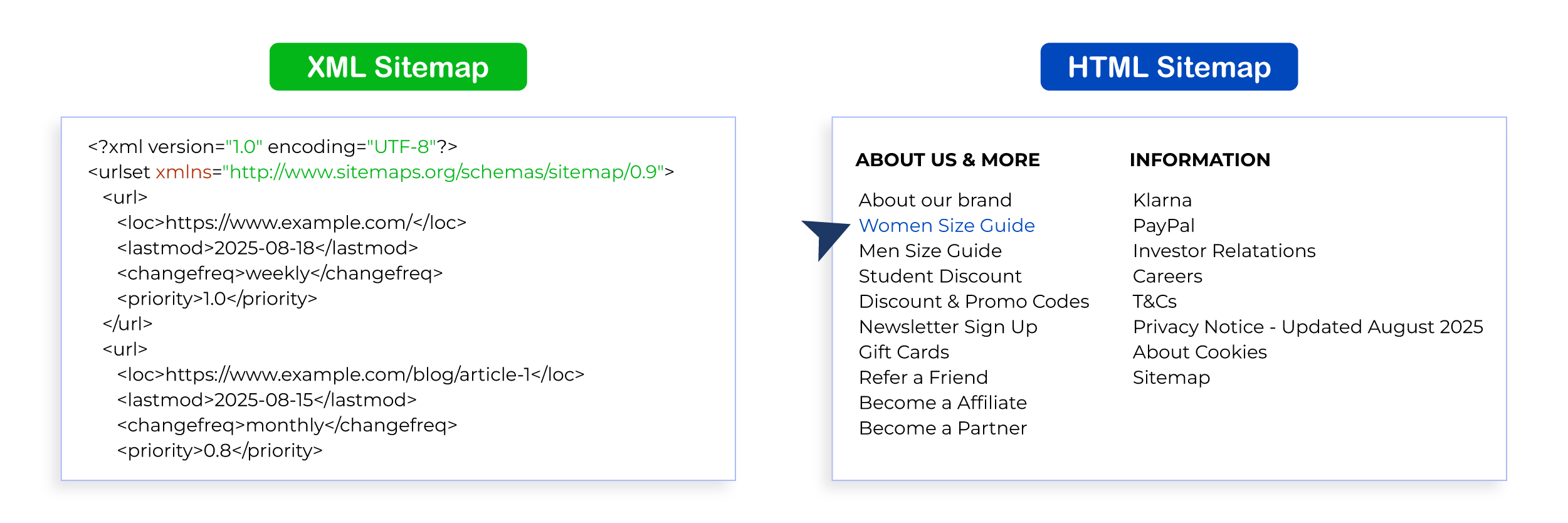
بينما تُستخدم خرائط مواقع XML وHTML لتنظيم محتوى موقعك الإلكتروني، إلا أن غرضيهما يختلفان. صُممت خرائط مواقع XML في المقام الأول لمحركات البحث، مما يساعد برامج الزحف على اكتشاف صفحاتك وفهرستها بكفاءة أكبر. أما خرائط مواقع HTML، فتركز على تجربة المستخدم، وتوفر دليلاً واضحًا للزوار لتصفح موقعك الإلكتروني. يضمن استخدام كلا النوعين بشكل استراتيجي فهرسة أفضل، وتصفحًا أفضل، وتحسينًا شاملًا في محركات البحث.
ميزة | خريطة الموقع XML | خريطة الموقع HTML |
غاية | لمحركات البحث وأدوات الزحف | للزوار البشر |
شكل | ملف XML منظم | صفحة ويب تحتوي على قائمة الروابط |
الفهرسة | يساعد محركات البحث في العثور على جميع الصفحات بسرعة | لا يؤثر بشكل مباشر على الفهرسة |
الربط الداخلي | محدودة؛ بشكل أساسي للإشارة إلى الزاحف | يوفر فرص ربط داخلية قوية |
تغطية المحتوى | يمكن أن يتضمن عددًا كبيرًا من عناوين URL (ما يصل إلى 50000 لكل خريطة موقع) | عادةً ما تسرد الصفحات الرئيسية؛ وقد لا تتضمن جميع عناوين URL |
أفضل الممارسات | الحفاظ على XML صالحًا ومحدثًا؛ تضمين عناوين URL متعددة اللغات لتحسين محركات البحث الدولية | تنظيمها بشكل منطقي؛ تسهيل التصفح؛ ربط الصفحات المهمة. |
باستخدام خرائط مواقع XML لتحسين محركات البحث وخرائط مواقع HTML لتوجيه زوارك، يمكنك إنشاء موقع إلكتروني أكثر سهولة في الاكتشاف والاستخدام. يتكامل هذان العنصران معًا، مما يضمن وصول محركات البحث والمستخدمين إلى محتواك بفعالية.
أهمية خرائط المواقع المترجمة لتحسين محركات البحث لموقع الويب الدولي
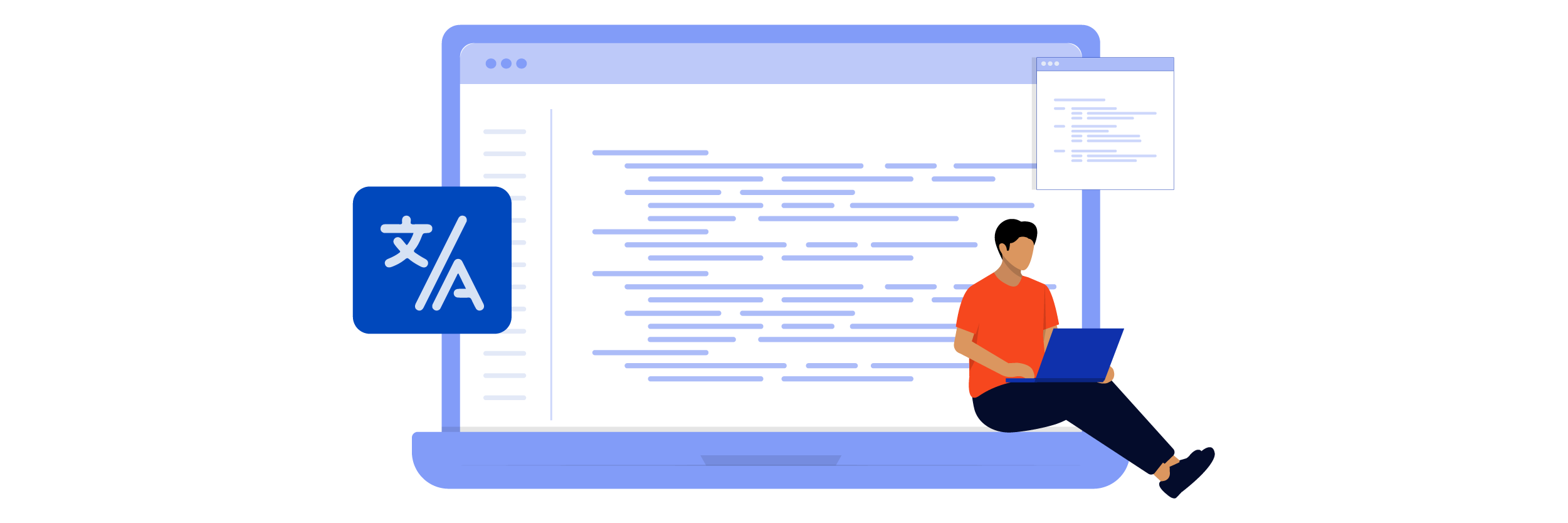
تحسين موقعك الإلكتروني للغات متعددة يتجاوز مجرد ترجمة المحتوى. فاستخدام خرائط المواقع المترجمة يضمن لمحركات البحث اكتشاف جميع إصدارات صفحاتك وفهرستها، مما يساعد موقعك على الوصول إلى جمهور أوسع وتحسين أداء تحسين محركات البحث بشكل عام.
- فهرسة مُحسّنة للصفحات متعددة اللغات: تُمكّن ترجمة خرائط المواقع محركات البحث من فهرسة موقعك الإلكتروني بجميع لغاته. على سبيل المثال، قد يُؤدي موقع يحتوي على 10 لغات و50 صفحة إلى فهرسة 500 صفحة، مما يُحسّن ظهورك بشكل ملحوظ في نتائج البحث العالمية.
- تحسين فهم محركات البحث لهيكلية الموقع الإلكتروني: تساعد خرائط المواقع متعددة اللغات محركات البحث على فهم هيكلية موقعك الإلكتروني وتخطيطه. هذا يضمن فهم برامج الزحف للعلاقات بين الصفحات بمختلف اللغات، مما يقلل من خطر إغفال المحتوى أو أخطاء الفهرسة.
- تحسين فرص التصنيف والظهور: من خلال إتاحة جميع الصفحات المترجمة لمحركات البحث، يُمكن لموقعك الإلكتروني المنافسة في المزيد من أسواق البحث. تُساهم الصفحات متعددة اللغات المُفهرسة في تحسين التصنيف، مما يؤدي إلى زيادة الزيارات العضوية ونمو الجمهور.
- دعم استراتيجيات تحسين محركات البحث الدولية: يتوافق استخدام خرائط المواقع المترجمة مع أفضل الممارسات في تحسين محركات البحث الدولية . فهي تُكمّل استراتيجيات أخرى، مثل وسوم hreflang، مما يُساعد محركات البحث على عرض النسخة اللغوية الصحيحة للمستخدمين بناءً على موقعهم وتفضيلاتهم.
تثبيت البرنامج المساعد Yoast SEO وتفعيل إنشاء خريطة الموقع

نظام إدارة محتوى موقعك الإلكتروني واستخدامها لإنشاء خرائط مواقع XML. ويظل استخدام إضافة Yoast SEO الخيار الأمثل لعدة أسباب.
يساعد برامج الزحف لمحركات البحث من خلال تحديد أولويات الصفحات الأكثر أهمية في موقع الويب الخاص بك. بالإضافة إلى ذلك ، فهو يساعد في مشاركة عناصر التعريف مما يسمح لمحركات البحث بتحديد تاريخ آخر تحديث للمحتوى الخاص بك. بالإضافة إلى ذلك ، يتيح لك استخدام Yoast التحكم في المعلومات المضمنة في خريطة موقعك.
تثبيت وتفعيل البرنامج الإضافي Yoast SEO
لتثبيت إضافة Yoast SEO، سجّل دخولك إلى نظام إدارة محتوى موقعك. في هذا الشرح، سنستخدم WordPress كمثال. بعد تسجيل الدخول، انقر على "الإضافات". عند إعادة توجيهك إلى صفحة الإضافات، انقر على "إضافة جديد" ثم ابحث عن إضافة Yoast SEO. لمن لم يُثبّت الإضافة، انقر على "تفعيل" لإضافتها إلى نظام إدارة محتوى موقعه.
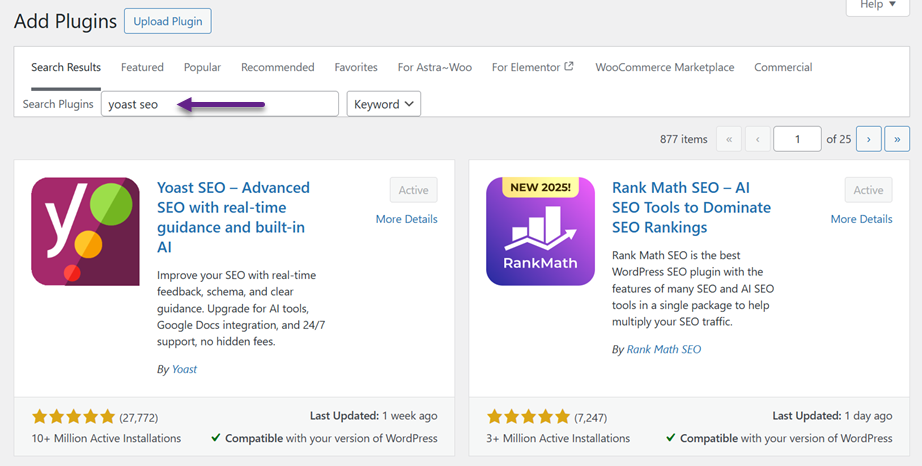
تمكين ميزة خريطة الموقع XML
بعد تثبيت الإضافة، افتح خيار "Yoast SEO" في لوحة التنقل، ثم انقر على "الإعدادات". بعد الوصول إلى إعدادات Yoast SEO، اكتب XML Sitemaps في حقل البحث.
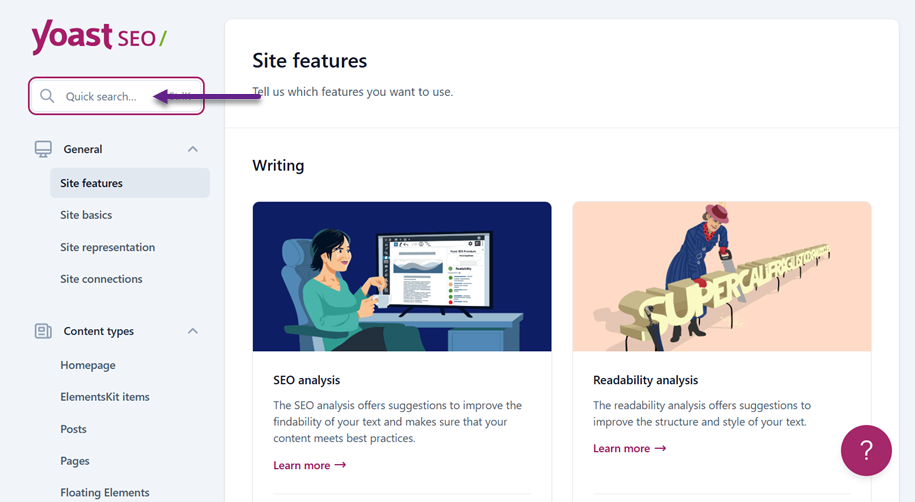
ستظهر الشاشة التالية. انقر على "تفعيل"، ثم انقر على "عرض خريطة موقع XML" للمتابعة.
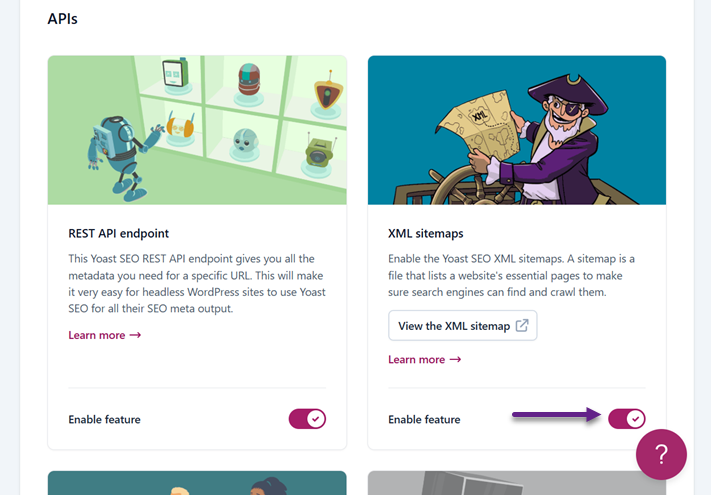
سيقوم مكون Yoast SEO بتوجيهك إلى صفحة ويب حيث سيتم إدراج جميع ملفات خريطة الموقع XML.
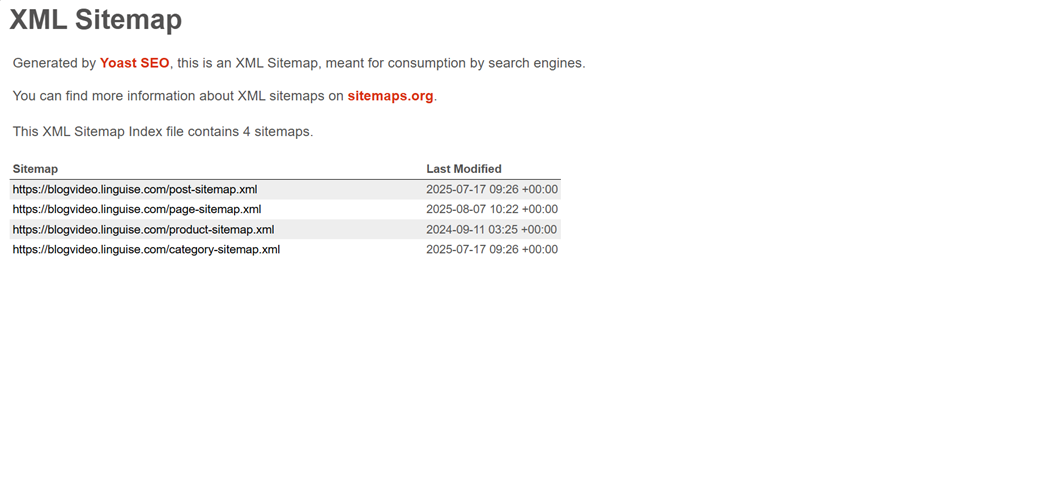
من هنا، يمكنك عرض خرائط المواقع الفردية لجميع صفحات موقعك الإلكتروني بالنقر على ملف XML المقابل وفتحه. لنلقِ نظرة على رابط "page-sitemap.xml" من مثالنا.
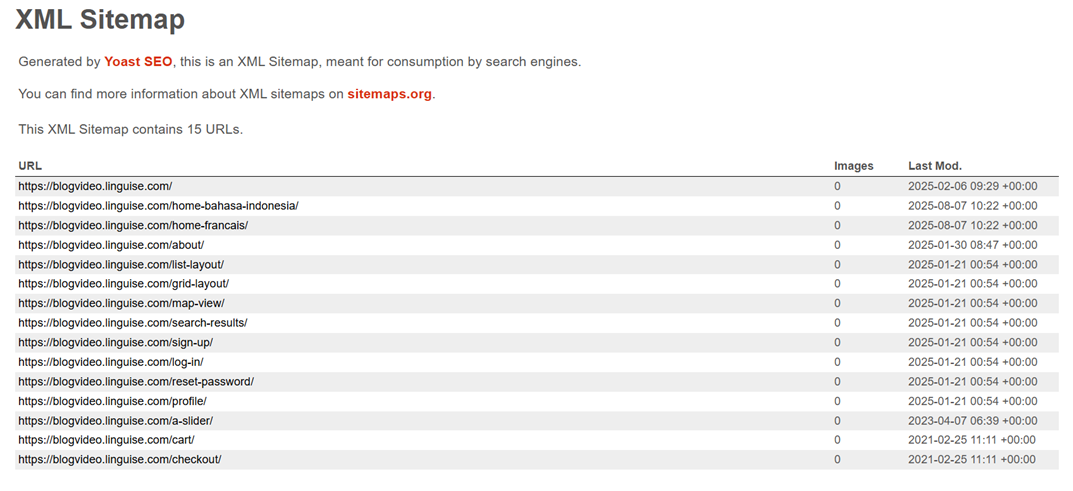
استبعاد نوع المحتوى من خريطة موقع XML
يمكنك استبعاد أنواع محتوى محددة من خريطة موقعك XML في قسم "أنواع المحتوى" ضمن إعدادات Yoast SEO. ما عليك سوى تحديد نوع المحتوى الذي تريد استبعاده (مثل المنشورات) ثم تفعيل المفتاح بجوار "إظهار المنشورات في نتائج البحث" لتعطيله.
بعد إتمام هذه الخطوات، لن يظهر هذا المحتوى في خريطة موقعك XML. هذا لا يعني أننا نوصي باستبعاد منشوراتك أو صفحاتك تمامًا من خريطة موقعك. مع ذلك، يمنحك هذا تحكمًا كاملاً في أنواع المحتوى المضمنة، مما يسمح لك بتخصيص خريطة موقعك XML بما يتناسب مع استراتيجية تحسين محركات البحث الخاصة بك.
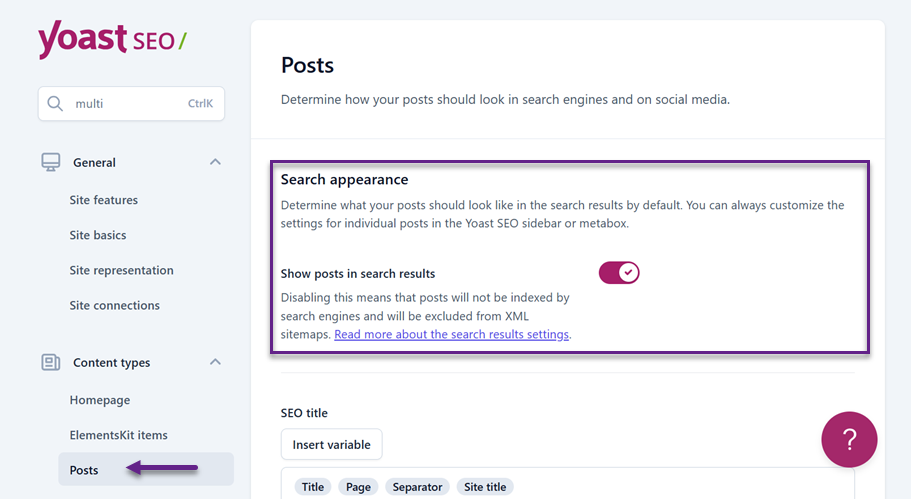
ترجمة خريطة موقع Yoast SEO XML
بالإضافة إلى عرض خريطة موقعك، يتعين عليك تضمين المنشورات المترجمة والصفحات وأنواع المنشورات المخصصة في خريطة موقعك XML.
مع بعض إضافات WordPress الشائعة، مثل Polylang، تُجرى هذه العملية يدويًا. عادةً ما يتعين عليك تفعيل ترجمات أنواع المنشورات المخصصة الصحيحة في إعدادات الإضافة. قد لا تكون أنواع المحتوى أو التصنيفات المحددة الأخرى مدعومة، مما يُصعّب تضمينها.
مع ذلك، مع الترجمة الآلية Linguise ، يمكنك تخطي جميع الأعمال اليدوية. Linguise خريطة موقعك XML تلقائيًا. للقيام بذلك، تأكد من تثبيت إضافة Linguise على WordPress ، وتعيين مفتاح API، وإضافة اللغة المطلوبة (مثل الفرنسية).

للبدء، انقر على ملف خريطة الموقع XML الذي تريد ترجمته. على سبيل المثال، سنستخدم "post-sitemap.xml". ثم أضف اللغة المطلوبة، مثلاً /fr/ للغة الفرنسية. في هذا المثال، ستؤدي إضافة "fr" إلى عنوان URL إلى ترجمة جميع عناوين URL في "post-sitemap.xml" تلقائيًا إلى الفرنسية.
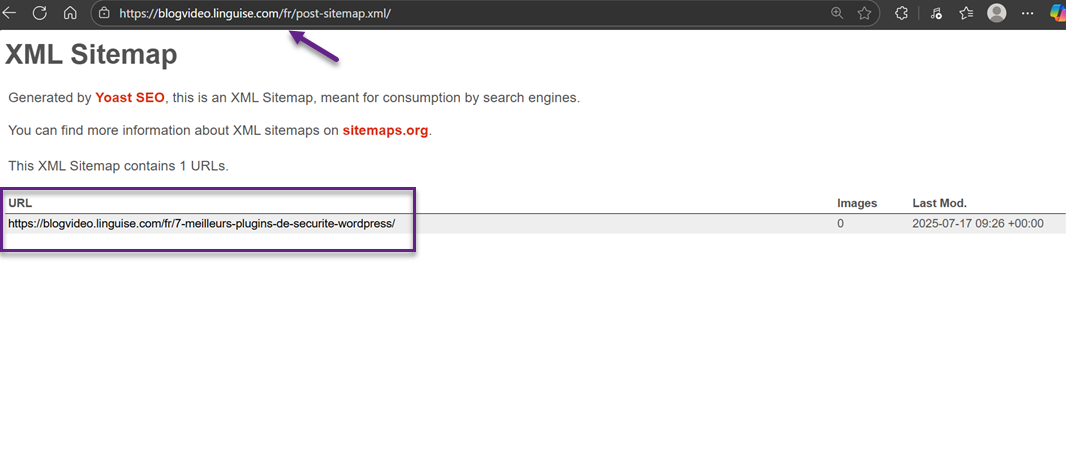
نظرًا لأن Linguise يترجم عناوين URL لمواقع WordPress بشكل مباشر وليس حسب نوع المحتوى، فإنه يجعل من الأسهل بكثير تضمين 100% من المحتوى الخاص بك في خريطة الموقع المترجمة.
يمكنك التحقق من ذلك في Linguise لوحة تحكم إدارة Linguise لموقعك "الترجمات" من القائمة العلوية. من القائمة المنسدلة، اختر "ترجمات عناوين URL".
هنا، سترى جميع ترجمات عناوين URL التي أنشأها Linguise. بما أن Linguise يُنشئ جميع عناوين URL المترجمة تلقائيًا، يمكنك بسهولة إنشاء خريطة موقع متعددة اللغات.
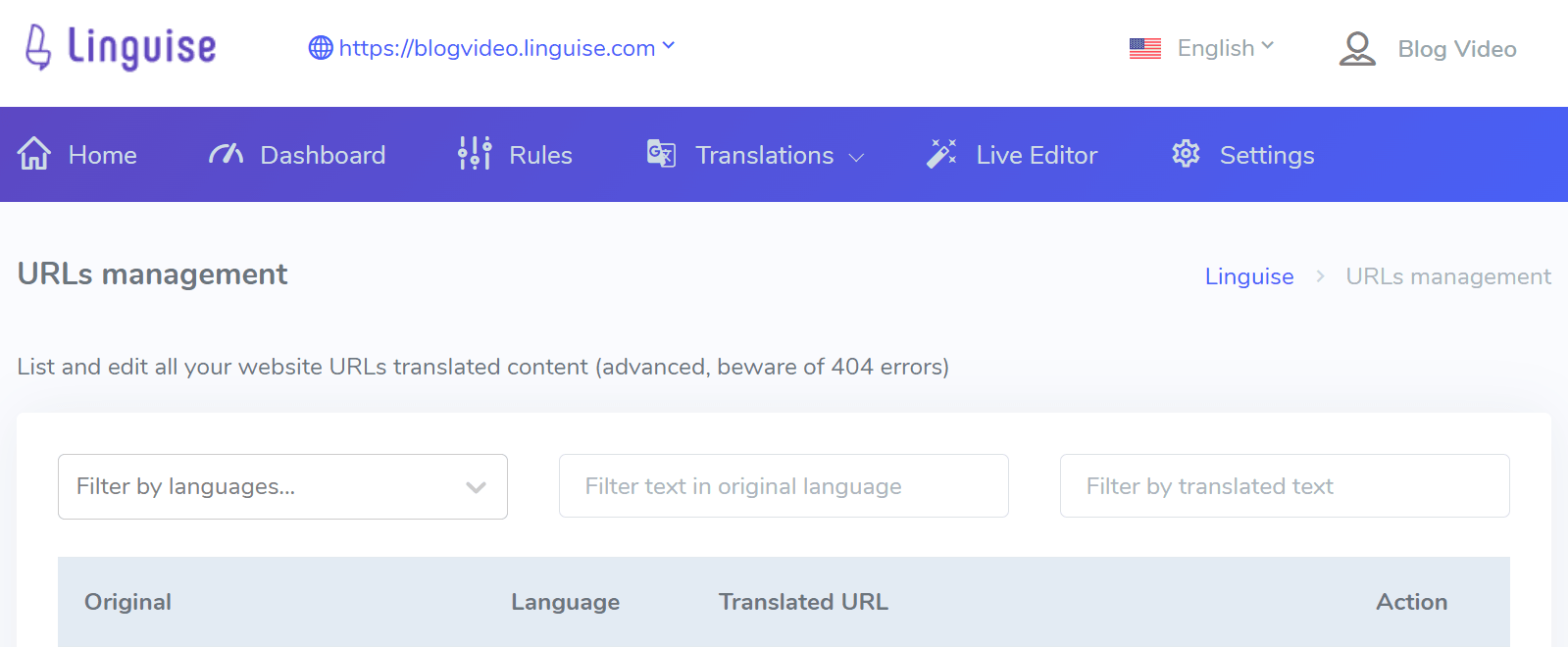
إرسال خريطة موقع Yoast SEO XML متعددة اللغات
بعد ترجمة خريطة الموقع XML متعددة اللغات من Yoast SEO، سنحاول بعد ذلك إرسالها إلى Google Search Console لضمان فهرسة الصفحة متعددة اللغات بشكل صحيح.
للقيام بذلك، تأكد من إعداد Google Search Console للمواقع متعددة اللغات. بعد ذلك، افتح قائمة "خرائط المواقع"، ثم أدخل خريطة الموقع المترجمة مسبقًا، ثم انقر على "إرسال" .
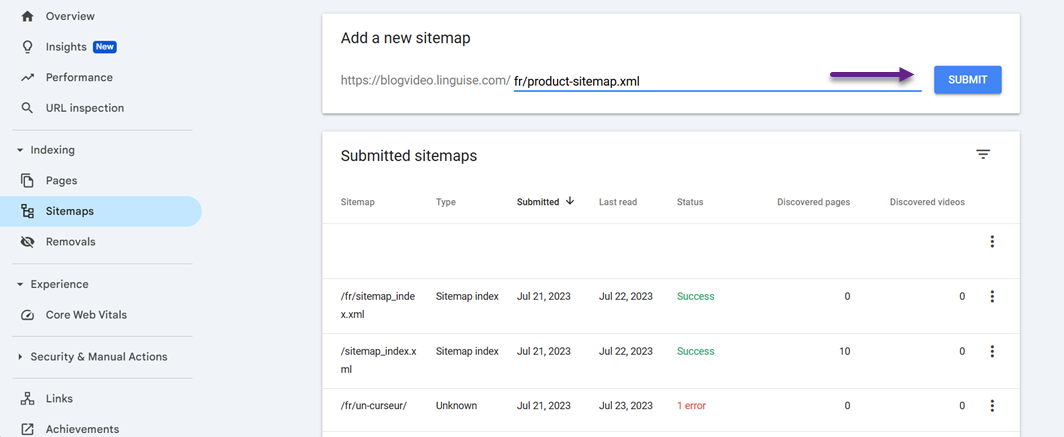
ثم، إذا نجحت العملية، ستظهر حالة النجاح كما هو موضح أدناه.
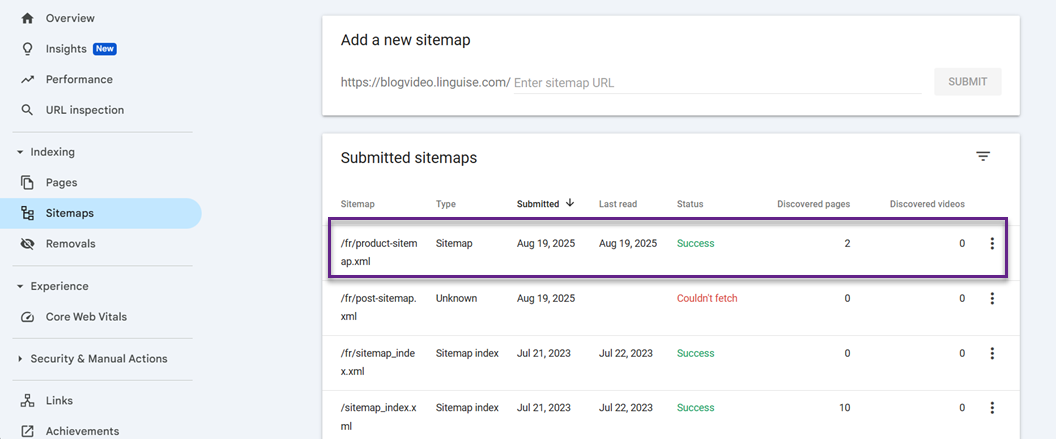
عند النقر عليه، سيتم نقلك إلى تفاصيل معلومات خريطة الموقع، حيث تكتشف خريطة الموقع صفحتين.
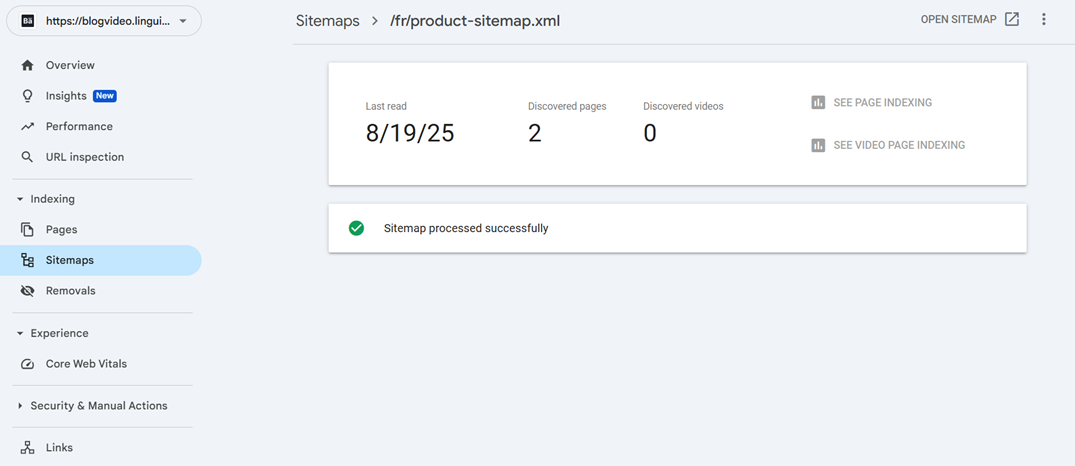
استكشاف أخطاء خريطة الموقع وإصلاحها في Google Search Console
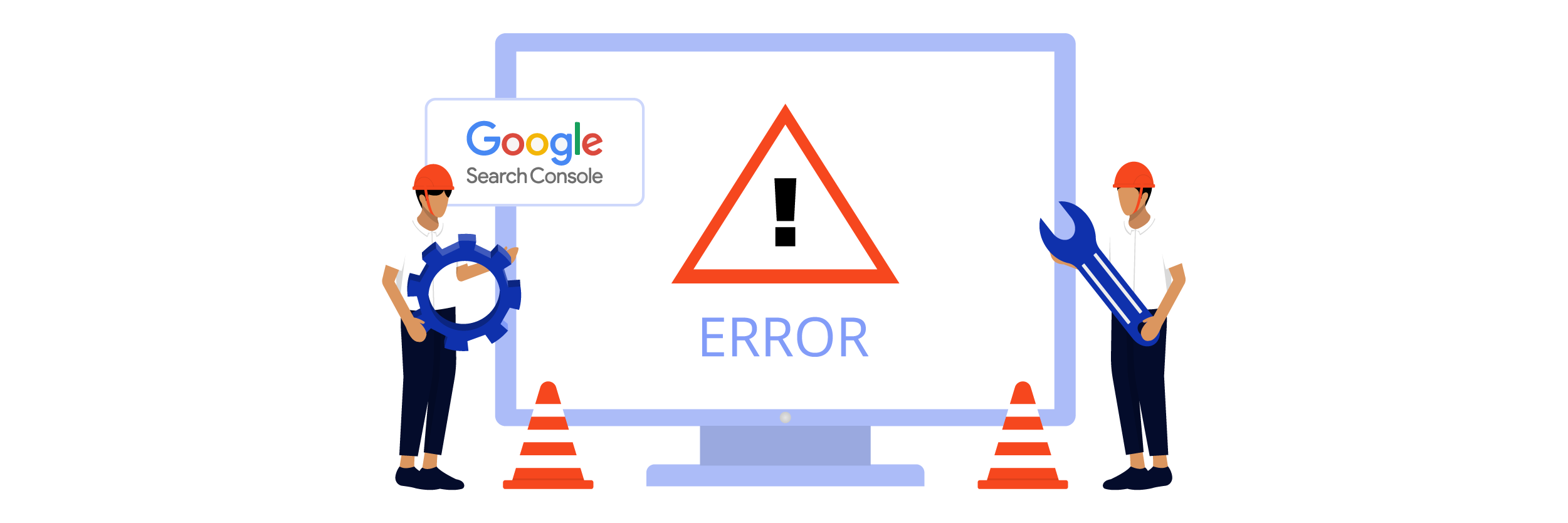
عند إرسال خرائط مواقع XML مترجمة، قد تواجه أخطاءً أو مشاكل في Google Search Console (GSC). معالجة هذه المشاكل في الوقت المناسب تضمن فهرسة صفحاتك بشكل صحيح وظهورها للجمهور العالمي. فيما يلي الأخطاء الشائعة وكيفية حلها.
1. لم يتم العثور على خريطة الموقع (خطأ 404)
يظهر خطأ 404 عندما يتعذر على جوجل العثور على خريطة الموقع التي أرسلتها. يحدث هذا عادةً بسبب مسار URL غير صحيح، أو خريطة موقع لم تُنشأ بعد، أو تغييرات حديثة في بنية موقعك. بدون حل هذه المشكلة، لن تتمكن محركات البحث من الزحف إلى صفحاتك وفهرستها بشكل صحيح.
حل:
- قم بالتحقق من عنوان URL لخريطة الموقع عن طريق فتحه في المتصفح لتأكيد إمكانية الوصول إليه.
- تأكد من أن أحدث مكون إضافي لـ Yoast SEO (إصدار 2025) قد أنشأ خريطة الموقع بشكل صحيح.
- قم بتحديث عنوان URL لخريطة الموقع في Google Search Console إذا تغير بعد إعادة هيكلة موقع الويب أو تحديثات المكونات الإضافية.
2. خطأ في تحليل خريطة الموقع
تحدث أخطاء التحليل عندما يتعذر على جوجل قراءة بنية XML لخريطة موقعك. قد يكون السبب أحرفًا غير صالحة، أو بناء جملة XML غير صحيح، أو وسومًا بتنسيق غير صحيح. في حال عدم معالجة هذه الأخطاء، قد يتجاهل جوجل جزءًا من خريطة موقعك أو كلها، مما يؤثر على فهرسة صفحاتك.
حل:
- تأكد من أن خريطة الموقع تستخدم تنسيق XML الصحيح مع<urlset> ،<url> ،<loc> ، و<lastmod> العلامات.
- استخدم ميزة إعادة إنشاء خريطة الموقع في البرنامج الإضافي Yoast SEO 2025 المحدث.
- قم بإزالة أي أحرف أو مسافات تمت إضافتها يدويًا والتي قد تؤدي إلى كسر بناء جملة XML.
3. الصفحات غير المفهرسة
أحيانًا، حتى بعد قراءة جوجل لخريطة الموقع، قد لا تتم فهرسة بعض الصفحات. هذا غالبًا ما يحدث مع الصفحات متعددة اللغات أو المحتوى المُضاف حديثًا. لن تظهر الصفحات غير المفهرسة في نتائج البحث، مما يحد من ظهور موقعك.
حل:
- تأكد من أن جميع الصفحات المترجمة نشطة ويمكن الوصول إليها وغير محظورة بواسطة ملف robots.txt.
- استخدم Linguise للتأكد من أن الترجمة التلقائية تولد عناوين URL الصحيحة لخريطة موقعك متعددة اللغات.
- فحص عناوين URL الفردية في Google Search Console وطلب الفهرسة للصفحات المفقودة.
4. عناوين URL المكررة أو المشكلات الأساسية
قد تمنع عناوين URL المكررة أو العلامات الأساسية غير الصحيحة جوجل من فهرسة النسخة الصحيحة من صفحاتك. يحدث هذا غالبًا مع المواقع متعددة اللغات التي تتوفر فيها نسخ متعددة اللغات للمحتوى نفسه. قد يؤدي عدم معالجة هذه المشكلة إلى عقوبات تحسين محركات البحث (SEO) وتشويش في نتائج البحث.
حل:
- تأكد من أن كل عنوان URL في خريطة الموقع يشير إلى صفحة فريدة.
- قم بتكوين عناوين URL الأساسية بشكل صحيح باستخدام البرنامج الإضافي Yoast SEO (إصدار 2025) لكل صفحة.
- بالنسبة للمواقع متعددة اللغات، تأكد من أن كل إصدار لغة لديه علامة أساسية تشير إلى صفحة اللغة المقابلة لها.
5. إرسال خريطة الموقع معلق أو غير محدث
بعد إرسال خريطة الموقع، قد يُظهرها جوجل على أنها معلقة أو قديمة. قد يؤثر هذا التأخير على سرعة فهرسة الصفحات الجديدة أو المُحدّثة، مما قد يُبطئ ظهور موقعك في نتائج البحث.
حل:
- أعد إرسال خريطة الموقع في Google Search Console لبدء المعالجة.
- قم بتعيين تردد التحديث بشكل صحيح في Yoast SEO ليعكس تغييرات محتوى موقع الويب الخاص بك.
- تحقق من استجابات الخادم وتأكد من أن خريطة الموقع ليست محظورة أو مقيدة بواسطة ملف robots.txt أو أي إعدادات خادم أخرى.
النقاط الرئيسية في ترجمة خريطة موقع XML
إن استثمار بعض الوقت في إعداد خرائط مواقع XML باستخدام Yoast ثم استخدام أداة الترجمة الآلية Linguise لإنشاء إصدار متعدد اللغات ، سيجلب لك تحسينًا كبيرًا لتحسين محركات البحث.
يتيح لك إنشاء خرائط مواقع مترجمة مما يؤدي إلى فهرسة المزيد من عناوين URL وإمكانية الحصول على ترتيب أعلى مع نمو موقع الويب الخاص بك. ابدأ الآن وشاهد فوائد Linguise .




